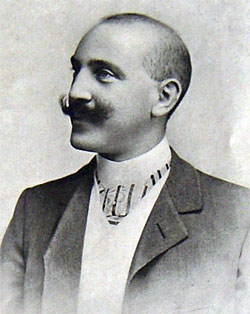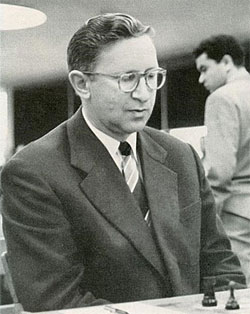



 Sergiy Didukh (*1976) is a Ukrainian chess composer whose influential weblog is in Russian with translator buttons for English, French, German and Ukrainian. There he held a section for the “Study of the Year 2015”, the officially discontinued project of the World Federation for Chess Composition, which was replaced by this series of articles, in cooperation with ChessBase, to propagate studies to the public, a role intended for the Study of the Year, by selecting the most suitable study to present to the general public.
Sergiy Didukh (*1976) is a Ukrainian chess composer whose influential weblog is in Russian with translator buttons for English, French, German and Ukrainian. There he held a section for the “Study of the Year 2015”, the officially discontinued project of the World Federation for Chess Composition, which was replaced by this series of articles, in cooperation with ChessBase, to propagate studies to the public, a role intended for the Study of the Year, by selecting the most suitable study to present to the general public.
While the selection was not an official event, the result still shall be presented here, and I want to thank Sergiy and the voters for the work put into the selection. The study of the Year also is the study of this month.
|
|

[Event "4th FIDE World Cup, 1st prize"] [Site "?"] [Date "2015.??.??"] [Round "?"] [White "Miljanic, Mirko"] [Black "White to play and win"] [Result "1-0"] [Annotator "Hornecker,Siegfried"] [SetUp "1"] [FEN "2q5/1k1n3Q/N5R1/2P5/4K3/8/5r2/8 w - - 0 1"] [PlyCount "19"] [EventDate "2015.??.??"] {As Black has strong threats after 1.-Qe8+, White must act quickly. The entire solution under this premise is very tactical.} 1. c6+ Ka8 (1... Kxa6 2. cxd7+ $18) 2. Nc7+ $1 {The correct move!} ({It looks promising to take on d7, but then Ka8 is incarcerated, leading to a stalemate defense:} 2. Qxd7 $2 Re2+ $1 3. Kf3 Qf8+ 4. Kxe2 {and now any check on f1 to f3 draws, for example} Qf2+ 5. Kxf2 $11) 2... Qxc7 ({Black must take, as for example} 2... Kb8 3. cxd7 $1 Qb7+ 4. Nd5 Qb1+ 5. Ke5 Qb2+ 6. Kd6 Qa3+ 7. Ke6 Qa6+ 8. Ke7 Qa3+ 9. Rd6 $1 Re2+ 10. Kf7 Qxd6 11. Qh8+ $1 Ka7 12. d8=Q Qe6+ 13. Kf8 Rf2+ 14. Nf6 $18 {wins. As Qh8 must protect the knight, 11.Qg8+ would only have been a draw.}) 3. Rg8+ Rf8 $1 {Black also deploys good tactics, hoping for stalemate.} (3... Nf8 4. Qxc7 { wins, as the Siegfried rook soon is stopped by the queen, most easily by} Re2+ 5. Kf5 Rf2+ 6. Kg4 (6. Qf4 $18) 6... Rg2+ 7. Kh3 $18) (3... Ka7 4. Qxd7 Rf4+ 5. Ke3 Rf7 6. Qd4+ $1 {and White will win soon, for example} Qb6 (6... Ka6 7. Ra8+ Kb5 8. Qa4+ Kc5 9. Ra5+ Kd6 10. Qd4+ Ke6 11. Qe4+ Kf6 12. Rf5+ Kg7 13. Rxf7+ Qxf7 (13... Kxf7 14. Qh7+ $18) 14. Qe5+ $18 {with a theory endgame. In this variation it was important for White to keep the initiative but also to find the right time to exchange pieces into a won endgame.}) 7. Ra8+ Kxa8 8. Qxb6 Rf3+ (8... Re7+ 9. Kd3 Rd7+ 10. Kc4 $18) 9. Ke2 $18) 4. Rxf8+ Nb8 {We have arrived at the heart of the study. Black has created a good defense, as he threatens to take on c6 or sacrifice his queen. If White plays Qg6, Black plays Qe7+. If White plays Qh6, Black plays Qh7+, and White taking the queen leads to a stalemate. So how can White win?} 5. Qh6 $3 {Still!} (5. Qxc7 $2 $11 ) 5... Qh7+ 6. Rf5 $3 (6. Qxh7 $2 $11) 6... Qxh6 {White is a queen down, but not for long:} 7. Ra5+ Na6 8. Rxa6+ Kb8 9. c7+ Kxc7 10. Rxh6 $18 {The queen sacrifice was only on time, White is a rook up and wins easily now.} 1-0
Mirko Miljanic (*1946) is a Serbian former financial sector worker (bank controller/reviser). He composes helpmates, long direct mates, such as “mate in 100 moves”, and endgame studies. [Information provided by Branislav Djurasevic].

Composers Branislav Djurasevic, Martin Minski, Mirko Miljanic und Borislav Ilincic, Belgrad 2016 [photo courtesy of Martin Minski]
Rooks were also a favorite piece of Austrian prosecutor Dr. Alois Wotawa.

[Event "Deutsche Schachzeitung"] [Site "?"] [Date "1960.??.??"] [Round "?"] [White "Wotawa, Alois"] [Black "White to play and win"] [Result "1-0"] [Annotator "Hornecker,Siegfried"] [SetUp "1"] [FEN "6R1/3K1Ppp/6k1/7n/6P1/np6/5r2/7R w - - 0 1"] [PlyCount "13"] [EventDate "1960.??.??"] {White has an easy draw in this position, but how is he supposed to win? The answer is, White must create a checkmate from nowhere. How this happens is very instructive.} 1. f8=Q $1 ({Winning material isn't enough:} 1. gxh5+ $2 Kxf7 2. Ra8 b2 $1 ({but in fact, keeping the knight should also be an easy draw:} 2... Nc4 $11) 3. Rxa3 Rd2+ 4. Kc6 Rc2+ 5. Kb5 Rc1 $11) 1... Rxf8 ({ The other defense leads to a won but difficult endgame:} 1... Rf7+ 2. Qxf7+ (2. Ke6 $2 Nf4+) 2... Kxf7 3. Rb8 Nf6+ 4. Kd8 $1 Nxg4 5. Rxb3 Nc4 6. Rxh7 $18 { and White eventually should win.}) 2. gxh5+ ({Taking the rook doesn't win:} 2. Rxf8 $2 Nf6+ 3. Ke6 b2 4. Rb8 b1=Q 5. Rbxb1 Nxb1 6. Rxb1 Nxg4 7. Rg1 h5 $11) 2... Kf7 {What now? Exchanging the rooks should lead to a drawn position, or not? Indeed, but White has an absurd move that creates a mating net.} 3. Rh8 $3 {An incredible sacrifice, but Black's rook will be incarcerated and block the own king.} (3. Rxf8+ $2 Kxf8 4. Rf1+ Kg8 5. Ke7 (5. h6 gxh6 6. Ke7 h5 $1 7. Rg1+ Kh8 8. Kf7 h6 $11) 5... h6 6. Rf8+ Kh7 7. Rb8 Nc4 8. Rxb3 Ne5 9. Rg3 (9. Ke6 Ng4 10. Rb5 Nf6 11. Kf7 Ne4) 9... Kg8 10. Ke6 Nf7 11. Rg1 Ng5+ 12. Kf5 Kf7 13. Ra1 Kg8 14. Kg6 Nh7 $11 {and Black just has a fortress.}) 3... Rxh8 (3... b2 4. Rf1#) 4. Rf1+ Kg8 {White only needs to find one more small trick and he wins easily:} 5. h6 gxh6 ({or} 5... g6 6. Ke7 $18 {with mate next move.}) 6. Ke7 b2 7. Rg1# {Black is checkmated. In fact, many Wotawa studies are about building a mating net in a position where it seems that none is easily possible. This is one of his easier(!) studies in that regard, particularly so by it having been also reprinted numerous times.} 1-0
 I asked Klaus Wenda, an Austrian prosecutor himself, for details on Wotawa once, but he replied that in Austria the different generations usually would not talk to each other. An email to the Austrian prosecution office a few years back also was never replied to. Thankfully, some historians in addition to Wotawa’s books shed light on the mystery of his biography:
I asked Klaus Wenda, an Austrian prosecutor himself, for details on Wotawa once, but he replied that in Austria the different generations usually would not talk to each other. An email to the Austrian prosecution office a few years back also was never replied to. Thankfully, some historians in addition to Wotawa’s books shed light on the mystery of his biography:
Alois Wotawa (1896-1970) was an Austrian prosecutor, mainly on the field of economic offences. According to research published in feenschach, Wotawa worked as judge for a while, where he also handed out death sentences, as was the law of that time.
For his around 350 endgame studies and some problems, Wotawa received the title of International Master for Chess Composition in 1966. A personal collection of his best 150 studies can be found in his 1965 book “Auf Spurensuche mit Schachfiguren” where Wotawa also published a short Sherlock Holmes story. Sadly this was his only chess book. [Thanks to Schwalbe president Bernd Gräfrath for some information, as I have not read the feenschach article!]
Years before, prominently the endgame of two against two rooks had been examined by a great classical composer. Here is only one of the studies of him.

[Event "La Stratégie"] [Site "?"] [Date "1921.02.??"] [Round "?"] [White "Rinck, Henri"] [Black "White to play and win"] [Result "1-0"] [Annotator "Hornecker,Siegfried"] [SetUp "1"] [FEN "5rk1/8/7K/8/8/7R/4R3/r7 w - - 0 1"] [PlyCount "17"] [EventDate "1921.??.??"] {Instead of the often reprinted study from National Zeitung, 13 May 1921, I'd like to show this example of Rinck's double rook studies, displaying an interesting manoeuver. Of course, everything has to happen with check, and White needs to set up his royal battery in the first move.} 1. Rg2+ Kh8 ({ Moving away costs the rook:} 1... Kf7 2. Rf3+ Ke7 3. Re2+ $18) {Now the manoeuver begins.} 2. Kg5+ Kg7 3. Kh4+ Kh6 4. Kg3+ Kg5 5. Kh2+ Kf4 $1 6. Rf2+ Kg4 $1 7. Rg3+ ({An important zwischenschach, as} 7. Rxf8 $2 Ra2+ $11 {would lose Rh3.}) 7... Kh4 8. Rxf8 Ra2+ 9. Rg2 {and White easily wins. The study was not difficult, but beautiful, and the manoeuver is of slight practical relevance.} 1-0
 Henri Rinck (1870-1952) was born into a brewer family, famous in Lyon with their “Brassérie Rinck”, from 1860 to 1970 at 66 Cours Suchet [source: “Capsules de Bieres Francaises” website]. According to Wikipedia, he graduated as a chemical engineer in Germany and founded a factory, apparently for the distillation of vegetal oil. As a cervisaphile, your author finds it a pity the Rinck brewery doesn’t exist anymore, as it would surely have been interesting to taste their beer. I found some interviews with a beer expert named Didier Rinck, who most likely is a member of the Rinck family, seeing as he – or someone else with the same name? – provided a death certificate of Henri Rinck to a chess committee in Lyon.
Henri Rinck (1870-1952) was born into a brewer family, famous in Lyon with their “Brassérie Rinck”, from 1860 to 1970 at 66 Cours Suchet [source: “Capsules de Bieres Francaises” website]. According to Wikipedia, he graduated as a chemical engineer in Germany and founded a factory, apparently for the distillation of vegetal oil. As a cervisaphile, your author finds it a pity the Rinck brewery doesn’t exist anymore, as it would surely have been interesting to taste their beer. I found some interviews with a beer expert named Didier Rinck, who most likely is a member of the Rinck family, seeing as he – or someone else with the same name? – provided a death certificate of Henri Rinck to a chess committee in Lyon.
In the field of endgame studies, Henri Rinck composed over 1600 works, 1414 of them being published in his magnum opus 1414 fins de partie on 11 February 1952, six days before his death. It served as a grave gift later, as Rinck’s body was burnt with a copy of the book under his arm. Seeing that several similar books were published before, it might be correct, although possibly misleading, to say the book took over four decades to write (if we assume the works published from 1909’s 150 fins de partie as earlier versions of the book).
Finally, I want to add a very famous study, serving as kind of a dessert for last month, mostly because I want to point out one aspect on the biography of the composer. Do you know why it was a lucky event for chess history that an aspiring baritone’s audition at the Bolshoi theater in 1950 failed?

[Event "Moi Etyudy, 2nd edition"] [Site "?"] [Date "2005.??.??"] [Round "?"] [White "Smyslov, Vasily"] [Black "White to play and draw"] [Result "1/2-1/2"] [Annotator "Hornecker,Siegfried"] [SetUp "1"] [FEN "3N4/4K2p/6k1/3ppp1p/7P/2pp1p2/8/2B5 w - - 0 1"] [PlyCount "21"] [EventDate "2005.??.??"] {White is fighting against a huge phalanx of pawns, and only by the correct and ingenious play with both pieces can a draw be reached. Smyslov shows here that in his later studies - this one was composed in 2003 - there are still crazy ideas. The first move here already is based on a semi-smothered mate, forcing Black, who already has advanced pawns, to hurry with his counterplay.} 1. Bh6 $1 c2 $1 ({Black must be careful, as White even wins after} 1... d2 $2 2. Nf7 f4 (2... d1=Q 3. Nh8+ Kxh6 4. Kf6 $18) 3. Ke6 d1=Q 4. Nh8+ Kxh6 5. Kf6 c2 6. Nf7#) ({Of course not} 1... Kxh6 2. Kf6 $18 {with the mate on f7.}) 2. Nc6 $1 ({It is important to choose the right square. A blunder is} 2. Nf7 $2 f4 $1 3. Nxe5+ (3. Ke6 c1=Q 4. Nh8+ Kxh6 5. Kf6 Qc6+ $19 (5... Qc7 $19)) 3... Kf5 4. Nxd3 f2 $19) {Again Black must be careful now.} 2... c1=Q $1 ({But not} 2... f4 $2 3. Ke6 c1=Q 4. Ne7+ $1 Kxh6 5. Kf6 Qg1 (5... Qc8 6. Nxc8 $1 $18) 6. Nf5#) 3. Bxc1 d2 $1 4. Nxe5+ Kg7 5. Bxd2 {Note that the last two moves of White could also have been played in reverse order, i.e. 4.B:d2 first.} f2 6. Bc3 $1 {Setting up the battery secures the draw.} ({Tempting but losing is} 6. Bh6+ $2 Kg8 $19) 6... Kg8 7. Nd7 $1 ({There is no checkmate after} 7. Nf7 $2 h6 $19 {.} ) 7... f1=Q {Black has nothing better, but now White forces the draw:} 8. Nf6+ Kg7 9. Ng4+ Kg6 10. Ne5+ Kh6 11. Nf7+ 1/2-1/2 Vasily Smyslov (1923-2010) was the young aspiring
 Vasily Smyslov (1923-2010) was the young aspiring Russian baritone who after the failed audition decided to pursue his chess career. Together with Mark Taimanov (piano) he performed classical works during chess events, not hindering him in the least to become the seventh world chess champion seven years later in 1957. Smyslov's composing career took off especially along with the deterioration of his eye sight . Chess composition kept him creative away of competitive chess.
Vasily Smyslov (1923-2010) was the young aspiring Russian baritone who after the failed audition decided to pursue his chess career. Together with Mark Taimanov (piano) he performed classical works during chess events, not hindering him in the least to become the seventh world chess champion seven years later in 1957. Smyslov's composing career took off especially along with the deterioration of his eye sight . Chess composition kept him creative away of competitive chess.
Aspiring in his games to harmony of the pieces, he left us works of even greater aesthetical value than his games - as he recorded several vinyls and CDs. Your author imagines Smyslov singing in heavenly opera houses next to the man he greatly admired, Enrico Caruso.
Here are two samples of his baritone skills:
Interpolis: Vassily Smyslov singing Stenka Rasin

PS: Zoltán Sárosy, the spirited chess master featured in our previous column, sadly has died – at the age of 110. If you haven't already please read the obituary by Albert Silver. You may also want to read this interview given before his 110th birthday and his autobiographical summary written in 2010 and reproduced with permission by Bob Armstrong, Scarborough.
I was deeply saddened to hear about his death.
 |
About the author
|